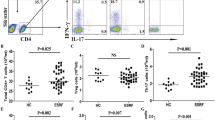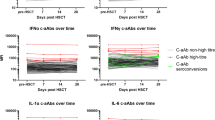Abstract
The purpose of this study was to evaluate T-cell immunity markers using serial post-transplantation monitoring of cytokine-producing cells during the first post-transplant months for the prediction of acute rejection and potentially chronic rejection of kidney allograft. We followed 57 kidney allograft recipients for meanly 3 years post-transplantation. Blood samples were collected pre-transplant, 2, 4 and 12 weeks post-transplant. The frequencies of IL-10-, IL-17- and IFN-γ-producing cells were determined in all time-points using ELISPOT assay. The results of ELISpot monitoring and levels of IL-23 and TGF-β were compared between recipients with acute (n = 12) or chronic rejection episodes and patients with stable graft function (n = 45). In all post-transplant time-points, significantly high frequencies of IFN-γ- and IL-17-producing cells and low frequency of IL-10-producing cells were observed in rejection group versus patients with stable graft function (P<0.0001). TheROCcurve analysis for determining the reliability of cytokine-producing cells for the prediction of acute rejection revealed that AUC was 0.046 for IL-10 (P<0.001), 0.927 for IL-17 (P<0.001) and 0.929 for INF-γ-producing cells (P<0.001). Our results indicate that analyzing the frequencies of INF-γ/IL-10/IL-17-producing cells may define a reliable panel for the prediction of acute rejection within the first post-transplant year which could also be applicable for the prediction of chronic rejection episodes.
Similar content being viewed by others

References
Pallardó Mateu LM, Sancho Calabuig A, Capdevila Plaza L, et al. Acute rejection and late renal transplant failure: risk factors and prognosis. Nephrol Dial Transplant 2004; 19: iii38–42.
Lebranchu Y, Baan C, Biancone L, et al. Pretransplant identification of acute rejection risk following kidney transplantation. Transpl Int 2014; 27: 129–38.
Viklicky O, Hribova P, Brabcova I. Molecular markers of rejection and tolerance: lessons from clinical research. Nephrol Dial Transplant 2013; 28: 2701–8.
Suthanthiran M, Schwartz JE, Ding R, et al. Urinary-cell mRNA profile and acute cellular rejection in kidney allografts. N Engl J Med 2013; 369: 20–31.
Crespo E, Lucia M, Cruzado JM, et al. Pre-transplant donor-specific T-cell alloreactivity is strongly associated with early acute cellular rejection in kidney transplant recipients not receiving T-cell depleting induction therapy. PLoS One 2015; 10: e0117618.
Gebauer BS, Hricik DE, Atallah A, et al. Evolution of the enzymelinked immunosorbent spot assay for post-transplant alloreactivity as a potentially useful immune monitoring tool. Am J Transplant 2002; 2: 857–66.
Crispim JC, Wastowski IJ, Rassi DM, et al. Interferon-gamma +874 polymorphism in the first intron of the human interferon-gamma gene and kidney allograft outcome. Transplant Proc 2010; 42: 4505–8.
de Menezes Neves PD, Machado JR, dos Reis MA, Faleiros AC, de Lima Pereira SA, Rodrigues DB. Distinct expression of interleukin 17, tumor necrosis factor alpha, transforming growth factor beta and forkhead box P3 in acute rejection after kidney transplantation. Ann Diagn Pathol 2013; 17: 75–9.
Rodrigo E, Arias M. A practical approach to immune monitoring in kidney transplantation. Minerva Urol Nefrol 2007; 59: 337–52.
Solgi G, Amirzagar AA, Pourmand G, et al. TH1/TH2 cytokines and soluble CD30 levels in kidney allograft patients with donor bone marrow cell infusion. Transplant Proc 2009; 41: 2800–4.
Amirzargar A, Lessanpezeshki M, Fathi A, et al. TH1/TH2 cytokine analysis in Iranian renal transplant recipients. Transplant Proc 2005; 37: 2985–7.
Mitchell P, Afzali B, Lombardi G, Lechler RI. The T helper 17-regulatory T cell axis in transplant rejection and tolerance. Curr Opin Organ Transplant 2009; 14: 326–31.
Mittal SK, Sharma RK, Gupta A, Naik S. Increased interleukin-10 production without expansion of CD4+CD25+ T-regulatory cells in early stable renal transplant patients on calcineurin inhibitors. Transplantation 2009; 88: 435–41.
Ghafari A, Makhdoomi K, Ahmadpour P, Afshari AT, Lak SS, Fakhri L. SerumT-lymphocyte cytokines cannot predict early acute rejection in renal transplantation. Transplant Proc 2007; 39: 958–61.
Mohammadi F, Niknam MH, Nafar M, et al. Dynamic changes of IFN-γ-producing cells, TGF-β and their preidctive value in early outcomees of renal transplantation. Int J Organ Transplant Med 2013; 4: 77–85.
Solez K, Colvin RB, Racusen LC, Haas M, Sis B, Mengel M. Banff 07 classification of renal allograft pathology: updates and future directions. Am J Transplant 2008; 8: 753–60.
Amirzargar MA, Amirzargar A, Basiri A, et al. Early post-transplant immune monitoring can predict long-term kidney graft survival: soluble CD30 levels, anti-HLA antibodies and IgA-anti-Fab autoantibodies. Hum Immunol 2014; 75: 47–58.
Amirzargar MA, Amirzargar A, Basiri A, et al. Pre-and posttransplant IgA-anti-Fab antibodies to predict long-term kidney graft survival. Transplant Proc 2015; 47: 1110–3.
Millán O, Rafael-Valdivia L, San Segundo D, et al. Should IFN-γ, IL-17 and IL-2 be considered predictive biomarkers of acute rejection in liver and kidney transplant? Results of a multicentric study. Clin Immunol 2014; 154: 141–54.
Hricik DE, Rodriguez V, Riley J, et al. Enzyme linked immunosorbent spot (ELISPOT) assay for interferon-gamma independently predicts renal function in kidney transplant recipients. Am J Transplant 2003; 3: 878–84.
Näther BJ, Nickel P, Bold G, et al. Modified ELISPOT technique–highly significant inverse correlation of post-Tx donor-reactive IFNgamma-producing cell frequencies with 6 and 12 months graft function in kidney transplant recipients. Transpl Immunol 2006; 16: 232–7.
Nickel P, Presber F, Bold G, et al. Enzyme-linked immunosorbent spot assay for donor-reactive interferon-gamma-producing cells identifies T-cell presensitization and correlates with graft function at 6 and 12 months in renal-transplant recipients. Transplantation 2004; 78: 1640–6.
Ranjbar M, Solgi G, Mohammadnia M, et al. Regulatory Tcell subset analysis and profile of interleukin (IL)-10, IL-17 and interferon-gamma cytokine-producing cells in kidney allograft recipients with donor cells infusion. Clin Exp Nephrol 2012; 16: 636–46.
Mohammadnia M, Solgi G, Ranjbar M, et al. Serum levels of interleukin (IL)-10, IL-17, transforming growth factor (TGF)-β1 and interferon-γ cytokines and expression levels of IL-10 and TGF-β1 genes in renal allograft recipients after donor bone marrow cell infusion. Transplant Proc 2011; 43: 495–9.
Hanidziar D, Koulmanda M. Inflammation and the balance of Treg and Th17 cells in transplant rejection and tolerance. Curr Opin Organ Transplant 2010; 15: 411–5.
Author information
Authors and Affiliations
Corresponding author
About this article
Cite this article
Mohammadi, F., Solgi, G., Tajik, M. et al. Enzyme-Linked Immunosorbent Spot (ELISpot) monitoring of cytokine-producing cells for the prediction of acute rejection in renal transplant patients. Eur Cytokine Netw 28, 93–101 (2017). https://doi.org/10.1684/ecn.2017.0397
Accepted:
Published:
Issue Date:
DOI: https://doi.org/10.1684/ecn.2017.0397



